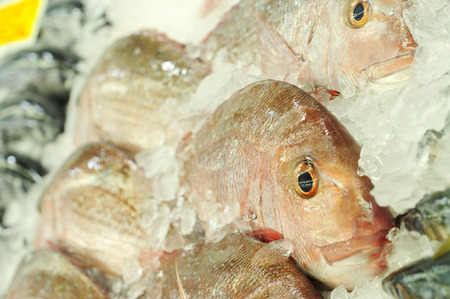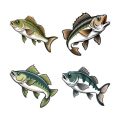Understanding Catch and Release
If you’re planning your first family fishing trip, you might have heard about “catch and release.” But what does it really mean? Simply put, catch and release is a fishing practice where you catch a fish, carefully unhook it, and return it to the water. This method isn’t just about letting fish go—it’s an important way to help protect our waterways and ensure that future generations can enjoy fishing too.
Why Do People Practice Catch and Release?
Let’s take a closer look at why so many American anglers choose this approach:
| Reason | Explanation |
|---|---|
| Conservation | Catching and releasing fish helps maintain healthy fish populations in lakes, rivers, and oceans. It’s a simple way to support wildlife conservation efforts. |
| Protecting Future Generations | By releasing fish back into the water, we make sure there are plenty of fish left for our kids—and their kids—to enjoy catching one day. |
| Respect for Wildlife | This practice shows respect for nature and all its creatures, teaching young anglers about responsibility and stewardship. |
| Sustainable Fishing | Catch and release helps keep fishing fun for everyone by preventing overfishing and allowing more people to experience the excitement of landing a big one! |
A Family-Friendly Approach to Fishing
Catching your first fish is always exciting—whether you’re six or sixty! Practicing catch and release can become a meaningful part of your family’s outdoor adventures. Not only does it keep the waters full of life, but it also gives you a chance to teach your kids about caring for the environment while having fun together.
2. Essential Gear for Safe Handling
When you’re out fishing with your family for the first time, having the right gear makes all the difference—especially when it comes to treating fish kindly and keeping everyone safe. Let’s look at some kid-friendly and family-friendly tools that make handling and releasing fish easier and safer for both anglers and fish!
Why Special Gear Matters
Using the right equipment helps protect fish from harm and ensures little hands are safe, too. With tools designed for beginners and kids, everyone can focus on enjoying the experience together.
Must-Have Tools for Families
| Tool | Why It’s Great for Families | How It Helps Fish |
|---|---|---|
| Barbless Hooks | Easier for kids to remove; less risk of injury to fingers | Minimizes damage to fish’s mouth; faster release time |
| Rubber Landing Nets | Softer on little hands; lightweight to carry and use | Protects fish scales and slime coat, reducing stress and injury |
| Padded Fish Grippers | Makes holding slippery fish easy without squeezing too hard | Keeps fish steady while avoiding harm to their bodies |
| Long-Nose Pliers or Hook Removers | Keeps fingers away from sharp hooks; easy for adults to help kids | Allows quick and gentle hook removal, lowering risk of hurting the fish |
| Wet Towel or Gloves (Fish-Friendly) | Helps kids grip fish gently; keeps hands clean and protected | Prevents removing the protective slime from fish skin, which is important for their health |
Tips for Using Kid-Friendly Fishing Gear
- Practice at Home: Let your child practice using nets and pliers before heading out. It builds confidence!
- Always Wet Your Hands: Remind kids to wet their hands or gloves before touching any fish. This keeps the fish healthier.
- Check Your Gear: Make sure everything is in working order before leaving home—especially if it’s your child’s first fishing trip.
- Praise Gentle Handling: Encourage gentle touch and slow movements when handling fish. Kids learn best with positive feedback.
A Family-Friendly Fishing Kit Checklist:
- Barbless hooks (in various sizes)
- A rubber landing net suitable for children’s reach
- Padded or foam-handled fish grippers
- A pair of long-nose pliers or a hook remover tool
- A small bucket of water or spray bottle to keep hands/gloves wet
- A soft, damp towel or special fishing gloves made for safe handling
- Sunscreen, hats, and plenty of water—because safety goes beyond just the fish!

3. Proper Techniques for Handling Fish
Step-by-Step Tips for Safe Fish Handling
If you’re out fishing with your kids for the first time, it’s super important to know how to handle fish gently. Not only does this help keep the fish healthy, but it also sets a great example for young anglers. Here’s a simple guide that both parents and children can follow together!
Step 1: Wet Your Hands First
Before you even touch the fish, dip your hands in the water. This helps protect the fish’s slime coat, which is like its natural shield against germs and disease.
- Why? Dry hands can remove the slime and hurt the fish.
- Tip: Keep a bucket of lake or river water nearby if you’re not close to the shore.
Step 2: Support the Fish Gently
Once your hands are wet, carefully lift the fish. Use both hands—one hand should go under its belly and the other near its tail.
- Don’t squeeze! Hold just firmly enough to keep it from slipping.
- Stay low over the water so if the fish wiggles free, it falls safely back in.
Step 3: Avoid Common Handling Mistakes
Mistakes happen, especially when everyone’s excited about their catch! Here’s a quick table to show what to do and what not to do:
| Do This | Avoid This |
|---|---|
| Wet your hands before touching fish | Handling with dry hands or towels |
| Support the belly and tail gently | Lifting by gills or squeezing tightly |
| Keep fish in water as much as possible | Leaving fish out of water for photos too long |
| Use barbless hooks if possible for easy removal | Pulling hooks roughly or using forceps incorrectly |
Family Tip:
If your child is nervous about holding a slippery fish, let them watch you first and then guide their hands with yours. Remember, patience makes it more fun and less stressful for everyone—including the fish!
4. How to Remove Hooks Safely
Why Gentle Hook Removal Matters
When you’re out fishing with your child for the first time, teaching them how to remove a hook from a fish is just as important as catching the fish itself. Removing hooks gently helps keep the fish healthy and makes the experience less stressful for both you and your little angler.
Simple Tools You’ll Need
| Tool | What It’s For | Tip for Kids |
|---|---|---|
| Pliers or Forceps | Grabbing and turning the hook safely | Hold gently and keep fingers away from the hook point |
| Barbless Hooks (or Pinched Barbs) | Makes removal much easier | If possible, use these for beginner fishing trips |
| Wet Towel or Gloves | Protects fish’s slime coat while handling | Remind your child to always wet their hands or towel first |
Step-by-Step Guide for Parents and Kids
- Stay Calm: If the fish is wiggling, gently hold it still. Encourage your child to speak softly—it helps calm the fish, too!
- Grip Gently: Hold the fish behind its head or around the body. Use a wet towel or glove to protect its scales.
- Locate the Hook: Find where the hook is in the mouth. If it’s visible and not too deep, it’s safe to proceed.
- Remove with Care: Using pliers or forceps, grasp the hook firmly but gently. Push down slightly to unhook it following the same path it went in. Teach your child to go slow and steady—no yanking!
- If It’s Deeply Hooked: If you can’t easily remove the hook, cut the line close to the hook instead of pulling hard. The fish has a better chance to recover this way.
- Check for Injuries: Take a quick look at the fish before releasing. A gentle rinse in water can help clear any blood or debris.
Troubleshooting Common Situations
| Situation | What To Do | Parent Tip |
|---|---|---|
| The hook won’t budge. | Cut the line as close as possible to the hook. | Praise your child for making a kind choice! |
| The fish is tangled in line. | Cautiously snip away extra line before release. | This keeps both fish and kids safer. |
| Your child feels nervous. | You demonstrate first, then guide their hands next time. | Laugh together and remind them: practice makes perfect! |
A Parent-Child Bonding Moment
This is a great opportunity to teach respect for nature while building confidence in your young angler. By showing how to handle hooks carefully, you’re helping create positive fishing memories that will last a lifetime—for both you and your child!
5. Best Practices for Releasing Fish
Interactive Ways to Return Fish to the Water
Releasing a fish back into its home is one of the most important parts of catch-and-release fishing, especially when you’re introducing your kids to the sport. Here are some fun and interactive ways to make sure you’re doing it right—and helping your child understand why every step matters!
Timing Is Everything
After catching a fish, try to release it as quickly as possible. The longer a fish is out of the water, the more stressed it gets. Explain this to your child: “Fish need water like we need air! Let’s help our new friend get back fast so it can swim strong.”
Quick-Release Steps
| Step | What To Do | Kid-Friendly Tip |
|---|---|---|
| 1. Get Ready | Have your tools (pliers, bucket) nearby before landing the fish. | Let your child fetch the tools—it makes them part of the action! |
| 2. Gentle Handling | Wet your hands before touching the fish to protect its scales and slime coat. | Show your child how “slippery” fish feel when their hands are wet. |
| 3. Remove Hook Carefully | If possible, use barbless hooks for easy removal. Use pliers if needed. | Let kids practice with a rubber fish toy first. |
| 4. Support the Fish | Hold the fish gently under its belly and keep it in the water if possible. | Help your child hold the fish with two hands, just above the surface. |
| 5. Release It Right Away | Point the fish’s head upstream or into calm water, then let go gently. | Count “one-two-three!” together before releasing—it adds excitement! |
The Importance of Placement When Releasing Fish
Where you put the fish back in matters. Always choose an area with gentle water flow and no immediate obstacles like rocks or weeds. Explain to your child that this helps the fish regain its strength safely—just like when we take a break after running around!
Teaching Kids Why Quick Release Matters
- Relate It to Breathing: Ask kids how long they can hold their breath and compare that to how fish need water to breathe.
- Create a Story: Make up a quick story about the fish going home to its family—kids love imagining what happens next!
- Praise Their Efforts: Celebrate each safe release with a high-five or photo (while keeping the fish wet!).
This interactive approach not only makes fishing fun but also teaches respect and care for nature—an experience your family will remember every time you go fishing together.
6. Teaching Respect and Responsibility
Fishing as a Family: More Than Just Catching Fish
For many American families, fishing is about more than just spending time outdoors—its about sharing life lessons, building memories, and developing a deep respect for nature together. Whether you’re at the local pond or on a lakeside vacation, each fishing trip offers an opportunity to talk with your kids about responsibility and kindness toward wildlife.
Sharing Our Family Story
I remember my sons excitement when he caught his very first sunfish at our favorite lake in Minnesota. As we gently unhooked the fish together, I explained why wetting our hands was important before touching it. “We want to protect its scales so it can swim away healthy,” I told him. Moments like these not only teach safe fish handling but also help kids understand that every living thing deserves care and respect.
Tips for Fostering Respect for Nature While Fishing
| Tip | Why It Matters | How to Share with Kids |
|---|---|---|
| Lead by Example | Children mimic adult behavior; your actions set the tone. | Show gentle handling and always pick up trash—even if its not yours. |
| Use Simple Explanations | Keeps lessons clear and memorable for young anglers. | “We release small fish so they can grow bigger.” |
| Celebrate All Catches—Big or Small | Encourages appreciation for every part of nature, not just trophies. | Take photos, talk about colors or patterns, then release safely. |
| Create Rituals Together | Makes outings meaningful and helps build family traditions. | Saying “thank you” to the fish before releasing it back to the water. |
| Talk About Conservation | Nurtures lifelong stewards of the outdoors. | Discuss local rules like catch limits or why certain areas are protected. |
Building Lifelong Values Through Experience
The conversations you have during these fishing trips matter. By asking questions like, “Why do you think it’s important to return this fish?” or “What else can we do to keep the lake clean?” you’re inviting your children to be curious and caring. These little moments add up and help shape a future generation who treasures and respects our natural world.

